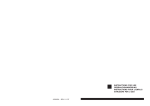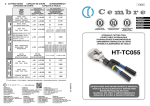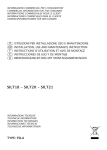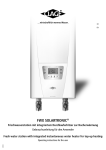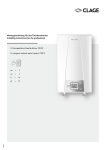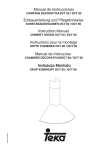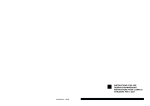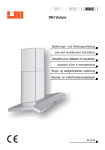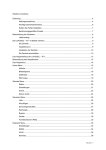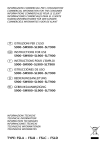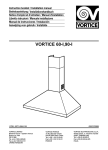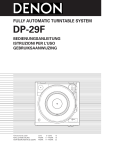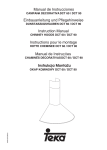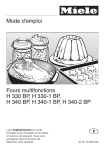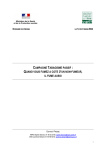Download EH 135 - Wesco
Transcript
INSTRUCTIONS FOR USE INSTRUCTIONS POUR L'EMPLOI GEBRAUCHSANWEISUNG ISTRUZIONI PER L'USO 04305564 - K ANGOLO English WARNING -------------------------------------------------------The distance between the hob and the lower part of the hood must be at least 65cm. The air collected must not be conveyed into a duct used to blow off smokes from appliances fed with an energy other than electricity (central heating systems, thermosiphons, water-heaters, etc.). Comply with the official instructions provided by the competent authorities in merit when installing the disposal duct. The room must be well aerated in case a hood and some other heat equipment fed with an energy other than electricity (gas, oil, coal heaters, etc) operate at the same time. In fact the intake hood, disposing of air, could create a vacuum in the room. The vacuum should not exceed 0,04mbar. This prevents the gas exhausted by the heat source from being intaken again. It is therefore advisable to ensure the room contains air taps able to ensure a steady flow of fresh air. ATTENTION: This appliance must be grounded. The following warning is valid in the United Kingdom only: As the colours of the wires in the mains lead of this appliance may not correspond with the coloured markings identifying the terminals in your plug, proceed as follows: - the wire which is coloured green and yellow must be connected to the terminal in the plug which is marked with the letter E or by the earth symbol [ ], or coloured green or green and yellow; - the wire which is coloured blue must be connected to the terminal which is marked with the letter N or coloured black; - the wire which is coloured brown must be connected to the terminal which is marked with the letter L or coloured red. When making the electrical connections, check that the current socket has a ground connection and that the voltage values correspond to those indicated on the data plate inside the appliance itself. In case your appliance is not furnished with a non separating flexible cable and has no plug, or has not got any other device ensuring omnipolar disconnection from the electricity main, with a contact opening distance of at least 3mm, such separating device ensuring disconnection from the main must be included in the fixed installation. INSTALLATION -------------------------------------------------------- Always switch off the electricity supply before carrying out any cleaning or servicing operations on the appliance. Remove the metal filters as described below (Fig. 2) before proceeding with the assembly operations. This will make the appliance easier to handle. USE -------------------------------------------------------Avoid using materials which could cause spurts of flame (flambées) near the appliance. When frying, take particular care to prevent oil and grease from catching fire. Already used oil is especially dangerous in this respect. Do not use uncovered electric grates. To avoid possible risks of fire always comply with the indicated instructions when cleaning anti-grease filters and when removing grease deposits from the appliance. MAINTENANCE -------------------------------------------------------Thorough servicing guarantees correct and long-lasting operation. Particular care must be paid to the grease filtering panels which must be periodically cleaned in relation to use (at least once every two months). Remove the grease filters and wash them either by hand or in the dishwasher using neutral detergent. Use lukewarm water and neutral detergent to clean painted appliances. Never use products containing abrasives. Take great care to prevent the use of corrosive or abrasive products when cleaning steel, copper or brass appliances. It is advisable to use specialized products according to the manufacturer’s instructions. This appliance is designed for angle installation. This appliance is designed for application as a suction unit i.e. that the air is evacuated outside (Fig.1). It consists of a hood and a telescopic bearing structure which must be applied to the upper part of the hood in order to cover the draft tube. This appliance is equipped with a provided "closing support" (Fig.3). This part is not necessary when you are in a situation as indicated in Fig.4, where, for example, there is an angle panel. If you would use the "closing support" before fixing the hood to the wall, assemble it as indicated in Fig.3. Then fix it to the bach part of the hood as indicated in Fig.5. Wall fixing with brackets Using the relative boring template, make the right holes to fix to the ceiling. Mind that the distance between the lower edge of the hood and the hob must be at least 650 mm. Apply the supplied brackets to the wall using the relative screws and screw anchors (Fig.6D). Before installing the hood, check that the bracket fixing screws (Fig.6A) have been sufficiently slackened to allow the hood itself to be fitted in place. Now fit on the hood using the relative rectangular slots situated at the rear of the appliance. The appliance can be regulated in height by means of the relative bracket adjuster screws (Fig.6B). Once having regulated the equipment, fix everything in place by tightening screws A (Fig.6) and inserting screws C (Fig.6). In case you do not use the "closing support", the bach of the hood is equipped with 2 provided holes for a possible safety fixing. Fixing the decorative pipe The following operations are essential for assembly: – Fit the wiring system within the decorative pipe. – Prepare the air disposal hole. 1. Using the supplied screws and screw anchors, fix the upper pipe bearing bracket to the ceiling (or to the wall too if you are in a position as in Fig.4), aligning it with the hood (Fig.7). 2. Connect the hood flange to the disposal hole on the ceiling, using a suitable tube. 3. Make the electrical connections. 4. Insert the upper decorative pipe (Fig.8A), fixing it to the bracket by means of the two side fixing screws. 5. Now mount the lower pipe, inserting it from the front part of the hood and expanding it lightly (Fig.8). Fix the parts using the relative screws, which must be inserted from the inside of the casing (Fig.9). OPERATION ------------------------------------------------------Switch A - LIGHT (Fig.10): Position 0: light off Position 1: light on Cursor B - MOTOR SPEED: Used to regulate the operative speed of the motor. Switch C - MOTOR: Position 0: motor off Position 1: motor on Warning light D: Indicates motor operation. Remove the metal filters for access to the internal parts of the appliance. This is carried out by pushing the relative catch inwards and turning it downwards until it disengages from the supports. Proceed with these instructions in reverse when refitting the filters (Fig. 2). If the light bulbs need changing, slacken the ring nut in an anticlockwise direction and remove the bulb itself (Fig. 2). Replace with a bulb of the same type. Français ATTENTION -------------------------------------------------------La distance entre la surface de la table de cuisson et la base de la hotte doit être d'au moins 65cm. L'air aspiré ne doit pas être canalisé dans un conduit qui est utilisé pour évacuer les fumées produites par des appareils alimentés par des sources d'énergies autres que l'énergie électrique (installations de chauffage central, radiateurs, chauffe-eau, etc.). Pour évacuer l'air qui doit être éliminé respectez les prescriptions des autorités compétentes. Prévoyez une aération de la pièce adéquate quand une hotte et des appareils alimentés par une énergie autre que l'énergie électrique (poêle à gaz, à huile, à charbon etc.) sont utilisés en même temps. En effet, en évacuant l'air, la hotte pourrait créer une dépression dans la pièce. La pression négative de la pièce ne doit pas dépasser 0,04mbar, évitant ainsi que la source de chaleur provoque un appel des gaz qui doivent être évacués. Il est donc nécessaire d'équiper la pièce de prises d'air alimentant un flux d'air frais constant. ATTENTION: cet appareil doit être relié à la terre. Lors du raccordement électrique assurezvous que la prise de courant est munie de connexion de mise à terre; vérifiez aussi que les valeurs de tension correspondent à celles qui sont indiquées sur la plaque des caractéristiques de l’appareil, qui se trouve à l'intérieur de celui-ci. Si votre appareil n'a pas de cable flexible qui ne peut pas être séparé et de prise, ou bien d'autre dispositif qui garantisse le débranchement de tous les pôles du réseau, avec une distance d'ouverture entre les contacts d'au moins 3mm, ces dispositifs de séparation du réseau doivent alors être prévus dans l'installation fixe. Avant de procéder à une opération d’entretien ou de nettoyage quelconque, débranchez l’appareil. UTILISATION -------------------------------------------------------Evitez d'utiliser des matériaux qui causent des flambées à proximité de l'appareil. Dans le cas de fritures, faites tout particulièrement attention au danger d’incendie que représentent les huiles et les corps gras. A cause de son inflammabilité l’huile usagée est particulièrement dangereuse. N'utilisez pas de grilles électriques découvertes. Pour éviter des risques d'incendie possibles suivez les instructions données concernant le nettoyage des filtres antigraisses et sur la façon d'enlever des dépots éventuels de graisse sur l'appareil. ENTRETIEN -------------------------------------------------------Un entretien soigné est une garantie de bon fonctionnement et de bon rendement de votre appareil dans le temps. Faites très attention surtout aux panneaux filtrants anti-graisse et nettoyez-les périodiquement (au moins tous les deux mois). Retirez les filtres anti-graisse et lavez-les avec un détersif neutre à la main ou dans le lave-vaisselle. Pour nettoyer les appareils peints, utilisez de l’eau tiède et du détersif neutre: évitez les produits abrasifs. Pour nettoyer les appareils en acier, cuivre et laiton, faites très attention: il ne faut absolument pas utiliser de produits abrasifs ou corrosifs. Nous conseillons d’employer des produits spécifiques et de suivre leurs modes d'emploi. INSTALLATION ------------------------------------------------------Cet appareil est prévu pour une installation angulaire. Cet appareil a été conçu pour fonctionner en version aspirante, c’est-à-dire pour évacuer l’air vers l’extérieur (Fig.1). Il est composé d’une hotte et d’un conduit télescopique décoratif qui doit être appliqué sur la partie supérieure de la hotte, en tant que revêtement du tuyau d’évacuation. Avant de monter l'appareil, pour le manoeuvrer plus aisément, enlevez les filtres métalliques en suivant les instructions ci-dessous (Fig. 2). Pour cette hotte nous vous fournissons en dotation un "support de fermeture" (Fig.3). Ce dernier n'est pas nécessaire si vous vous trouvez dans une situation comme dans la Fig.4, où, par ex., peut être présent un panneau dans l'angle. Si vous utiliserez le "support de fermeture" avant de fixer la hotte au mur assemblezle come indiqué à la Fig.3. Fixez-le sur la partie postérieure de la hotte come indiqué à la Fig.5. Fixation murale avec étriers A l'aide du gabarit de perçage faites les trous nécessaires au montage de votre modèle dans le mur en tenant compte du fait que la distance entre l'arête inférieure de la hotte et votre table de cuisson doit mesurer au moins 650 mm. Fixez les étriers au mur au moyen des vis et des chevilles en dotation (Fig.6D). Avant d’accrocher la hotte assurez-vous que les vis de fixation des étriers (Fig.6A) sont dévissés de manière à ce qu'il soit possible d'accrocher la hotte. Ensuite fixez la hotte au moyen des fentes rectangulaires qui se trouvent à l’arrière de l’appareil. Le réglage de l’appareil en hauteur se fait au moyen des vis des étriers (Fig.6B). Après ce réglage, fixez le tout en serrant les vis 6A et en introduisant les vis 6C. Si vous n'utilisez pas le "support de fermeture", il est prévu sur la partie postérieure de la hotte, 2 trous (Fig.6E) pour une éventuelle fixation au mur. Fixation de la cheminée décorative Pour l'assemblage il est nécessaire de: – Prévoir l’alimentation électrique à l'intérieur du conduit décoratif. – Prévoir le trou d’évacuation de l’air. 1. Au moyen des chevilles et des vis en dotation, fixez l’étrier supérieur de support du conduit décoratif au plafond (ou aussi à la paroi si votre situation est comme dans la Fig.4), de manière à ce qu’il soit aligné avec votre hotte (Fig.7). 2. Reliez la bride de la hotte au trou d’évacuation qui se trouve dans le mur/ plafond, au moyen d’un tuyau approprié. 3. Effectuez le raccordement électrique. 4. Introduisez le conduit décoratif supérieur en le fixant à l’étrier au moyen des deux vis de fixation latérales (Fig.8A). 5. Ensuite montez le conduit inférieur, en l’enfilant par le devant de la hotte en l'elargissant légerement (Fig.8) et fixez-le au moyen des vis qui doivent être introduites par l’intérieur de la structure (Fig.9). FONCTIONNEMENT -------------------------------------------------------Interrupteur A - ECLAIRAGE (Fig.10): Position 0: lumière éteinte Position 1: lumière allumée Curseur B - VITESSE DU MOTEUR: Permet le réglage de la vitesse de fonctionnement du moteur. Interrupteur C - MOTEUR: Position 0: moteur arrêté Position 1: moteur en marche Voyant D: Témoin de fonctionnement du moteur. Pour accéder à la partie interne de l’appareil vous devez enlever les filtres métalliques. Pour cela, débloquez le dispositif d’arrêt et poussez les filtres vers l’intérieur en les tournant vers le bas jusqu’à les dégager des supports. Pour remonter les filtres, effectuez ces mêmes opérations dans le sens inverse (Fig.2). Pour le remplacement des lampes halogènes, dévissez la bague dans le sens contraire aux aiguilles d'une montre et ôtez l'ampoule (Fig.2). Montez une ampoule de même type. Deutsch MONTAGE UND GEBRAUCHSANWEISUNG -------------------------------------------------------Das Gerät ist so zu montieren, daß der Abstand zwischen den Kochplatten und dem unteren Rand der Dunstabzugshaube mindestens 65 cm beträgt. Ein Anschluß der Abluftleitungen an Verbrennungs-Abgaskamine (z.B. Zentral-heizung usw.) ist nicht zulässig. In jedem Fall sind bei der Ableitung der Abluft die behördlichen Vorschriften zu beachten. Achtung! Bei gleichzeitigem Betrieb einer Abluft-Dunstabzugshaube und einer raumluftabhängigen Feuerstätte (wie z.B. gas, öl- oder kohlebetriebene Heizgeräte, Durch-lauferhitzer, Warmwasserbereiter) ist Vorsicht geboten, da beim Absaugen der Luft durch die Dunstabzugshaube dem Aufstellraum die Luft entnommen wird, die die Feuerstätte zur Verbrennung benötigt. Ein gefahrloser Betrieb ist möglich, wenn bei gleichzeitigem Betrieb von Haube und raumluftabhängiger Feuerstätte im Aufstellraum der Feuerstätte ein Unterdruck von höchstens 0,04 mbar erreicht wird und damit ein Rücksaugen der Feuerstättenabgase vermieden wird. Dies kann erreicht werden, wenn durch nicht verschließbare Öffnungen, (z.B. in Türen, Fenstern, Zuluft-/ Abluftmauerkasten, oder andere technische Maßnahmen, wie gegenseitige Verriegelung o.ä.), die Ver-brennungsluft nachströmen kann. Anmerkung: Bei der Beurteilung muß immer der gesamte Lüftungsverbund der Wohnung beachtet werden. Bei Betrieb von Kochgeräten, z.B. Kochmulde und Gasherd, wird diese Regel nicht angewendet. Im Zweifelsfalle muß der zuständige Schorn-steinfegermeister zu Rate gezogen werden. Beim elektrischen Anschluß müssen die Spannungswerte des Stromnetzes mit den Werten des im Inneren des Geräts angebrachten Typenschildes übereinstimmen. Vor jeder Reinigungs- oder Wartungsarbeit muß das Gerät vom Stromnetz getrennt werden. Falls das Gerät nicht an einer immer gut zugänglichen Steckdose angeschlossen wird, ist in der Installation eine allpolige Trennvorrichtung von Netz, mit einer Kontaktöffnungsweite von mindestens 3 mm pro Pol vorzusehen. GEBRAUCH -------------------------------------------------------Offenes Feuer, bzw. der Gebrauch von Elektrogrills unter dem Gerät ist zu vermeiden. Beim Fritieren, besonders mit mehrmals benutztem Öl, besteht Brandgefahr. Auch bei Nichtbeachtung der Reinigungsanweisungen besteht die Gefahr eines Brandes. WARTUNG -------------------------------------------------------Nur eine sorgfältige Pflege garantiert auf Dauer eine gute Leistung und Funktion des Geräts. Besonders wichtig ist die Reinigung der Fettfilter. Hierzu sind die Metallfettfilter abzunehmen. Die Reinigung wird von Hand, mit biologisch abbaubarem Reinigungsmittel, oder in der Spülmaschine empfohlen. Die Reinigungshäufigkeit hängt ab von der Benutzungsdauer und der Art der abzusaugenden Wrasen. Das Gerät selbst ist mit lauwarmem Wasser und mildem Reinigungsmittel, ohne Scheuerzusatz, zu reinigen. In keinem Fall sind kratzende, ätzende oder agres-sive Reinigungsmittel und Hilfsmittel zu verwenden. Verwenden Sie für Edelstahlgeräte Spezialprodukte zur Edelstahlpflege. die jeweilige Gebrauchsanweisung des verwendeten MONTAGE DES GERÄTS -------------------------------------------------------Dies Gerät ist für eine Eckanwendung vorgesehen. Zur Montage des Geräts sind die Metallfilter herauszunehmen (Abb.2). Diese werden hierzu am entsprechenden Griff leicht nach hinten gedrückt und nach unten aus der Federhalterung gezogen. Eingesetzt werden die Fettfilter im umgekehrten Handlungsablauf. Für diese Haube wird einen Schlusshaken geliefert (Abb.3). Dieser ist night notwending, wenn sie sich in einer Situation laut Abb.4 befinden, wo zum Beispiel es ein Eckepaneel gibt. Wenn Sie den Schlusshaken verwenden, vor der Wandbefestigung: Schlusschirm zusammenfassen (Abb.3). Dann Schirm an der Rückseite des Geräts befestigen (Abb.5). Wandmontage des Geräts: Die beiden mitgelieferten Haken unter Verwendung der Borschablone, mit, für die jewelige Wandkonstruktion geeigneten Dübeln und Schrauben an der Wand befestigen (Abb.6D). Bevor nun das Gerät mit den rechteckigen Öffnungen in der Geräterückwand in die Haken eingehängt wird, ist darauf zu achten, daß die Feststellschrauben (Abb.6A) an den Haken so weit gelöst sind, daß die Geräterückwand pro-blemlos in die Halterungen eingehängt werden kann. Die Höhenregulierung des Geräts erfolgt durch Verstellen der Regulierschrauben an den Aufhängehaken (Abb.6B). Nach genauer Einstellung der endgültigen Position werden die Feststellschrauben (Abb.6A) fest angezogen. Zusätzlich wird das Gerät durch die Sicherungslöcher fest mit der Wand ver-schraubt (Abb.6C). Wenn Sie den Schlusshaken nicht verwenden, sind 2 Löcher zur Sicherheitsbefestigung auf der Hinterseite der Haube vorgesehen (Abb.6E). Montage des Kamins: Es wird empfohlen, den elektrischen Anschluß für das Gerät im Bereich hinter der Kaminverkleidung vorzusehen. Zunächst wird die Position des Kaminbefesti- gungsteiles festgelegt. Dieses kann sowohl an der Decke, als auch an der Wand (wenn sie die situation Abb.4 haben) festgeschraubt werden (Abb.7). Nachdem der Abluftschlauch am Gerät angeschlossen ist und das Gerät mit dem Stromanschluß verbunden wurde, wird zunächst das Kaminoberteil von vorne über das Kaminbe-festigungsteil geschoben und seitlich festgeschraubt (Abb.8A). Bei dieser Operaktion den Kamin ein wenig ausweitern. Das Kaminunterteil wird von vorne eingeschoben (Abb.8) und vom Geräteinneren her mit dem Gehäuse verschraubt (Abb.9). SCHALTUNG DES GERÄTS -------------------------------------------------------Schalter A: Beleuchtung (Abb.10) Position 0: Beleuchtung ist ausgeschaltet Position 1: Beleuchtung ist eingeschaltet Schalter B: Motorgeschwindigkeit Schalter C: Motorhausptschalter - setzt das Ge-rät beim Einschalten in der zuletzt einge-sellten Betriebsstufe in Betrieb. Position 0: Motor ist ausgeschaltet Position 1: Motor ist eingeschaltet D: Kontrolleuchte für Motorbetrieb. Wechsel der Halogenlampen: Hierzu ist der Sicherungsring der zu wechselnden Halogenlampe abzunehmen, indem er ge-gen den Uhrzeigersinn gedreht wird (Abb.2). Nun kann die Halogenlampe gewechselt wer-den. Im Austauschfall sind unbedingt Halogenlampen des selben Typs zu verwenden. Nach dem Lampenwechsel ist der Sicherungsring wieder einzusetzen und im Uhrzeigersinn festzudrehen. Italiano AVVERTENZE -------------------------------------------------------La distanza minima tra la superficie del piano di cottura e la parte inferiore della cappa deve essere 65 cm. L'aria raccolta non deve essere convogliata in un condotto usato per lo scarico di fumi di apparecchi alimentati con energia diversa da quella elettrica (impianti di riscaldamento centralizzati, termosifoni, scaldabagni ecc.). Per lo scarico dell'aria da evacuare rispettare le prescrizioni delle autorità competenti. Prevedere un'adeguata areazione del locale quando una cappa e apparecchi alimentati con energia diversa da quella elettrica (stufe a gas, ad olio, a carbone ecc), vengono usati contemporaneamente. Infatti la cappa aspirante evacuando l'aria potrebbe creare una pressione negativa nella stanza. La pressione negativa del locale non deve superare i 0,04 mbar, evitando così il risucchio dei gas di scarico della fonte di calore. Pertanto attrezzare il locale con delle prese d’aria che alimentino un flusso costante di aria fresca. ATTENZIONE: Questo apparecchio deve essere collegato a terra. Nell’operazione di collegamento elettrico assicurarsi che la presa di corrente sia munita di collegamento di terra e verificare che i valori di tensione corrispondano con quelli indicati nella targhetta inserita all’interno dell’apparecchio. Se il Vostro apparecchio non è provvisto di cavo flessibile non separabile e di spina, o di altro dispositivo che assicuri la onnipolare disinserzione dalla rete, con una distanza di apertura dei contatti di almeno 3 mm, allora tali dispositivi di separazione dalla rete devono essere previsti nell'installazione fissa. Prima di procedere a qualsiasi operazione di pulizia o manutenzione è necessario togliere tensione. USO -------------------------------------------------------Evitare l’uso di materiali che causano fiammate (flambè) nelle immediate vicinanze dell’apparecchio. Nel caso di fritture fare particolarmente attenzione al pericolo di incendio che costituiscono olio e grassi. Particolarmente pericoloso per la sua infiammabilità è l’olio già usato. Non usare griglie elettriche scoperte. Per evitare un possibile rischio di incendio attenersi alle istruzioni indicate per la pulizia dei filtri antigrasso e la rimozione di eventuali depositi di grasso sull’apparecchio. MANUTENZIONE -------------------------------------------------------Un'accurata manutenzione garantisce un buon funzionamento ed un buon rendimento nel tempo. Una cura particolare va rivolta ai pannelli filtranti antigrasso, che devono essere puliti periodicamente in rapporto all'uso (almeno ogni due mesi). Disinserite i filtri antigrasso e lavateli con detersivo neutro a mano o in lavastoviglie. Per la pulizia di apparecchi verniciati adoperare acqua tiepida e detersivo neutro; evitare l'uso di prodotti contenenti abrasivi. Per la pulizia di apparecchi in acciaio, rame od ottone fate estrema attenzione ad evitare l'uso di prodotti contenenti abrasivi o corrosivi. È consigliato l'uso di prodotti specializzati, seguendo le istruzioni indicate sul prodotto. INSTALLAZIONE ------------------------------------------------------Il presente apparecchio è progettato per l'installazione ad angolo. Il presente apparecchio è progettato per impiego aspirante, cioè per evacuazione aria verso l’esterno (Fig.1) ed è composto da una cappa e da un camino decorativo telescopico che deve essere applicato sulla parte superiore della cappa quale rivestimento del tubo di scarico. – Predisporre l’alimentazione elettrica entro l’ingombro del tubo decorativo – Predisporre il foro evacuazione aria. 1. Mediante i tasselli e le viti in dotazione, fissare al soffitto (o anche alla parete se la vs. situazione è come in Fig.4) la staffa superiore di supporto del tubo decorativo, facendo in modo che sia in asse con la vostra cappa (Fig.7). 2. Collegare la flangia della cappa al foro di evacuazione sul soffitto, tramite un tubo adatto. Prima di procedere alle operazioni di montaggio, per una più facile manovrabilità dell’apparecchio disinserire i filtri metallici come descritto di seguito (Fig. 2). 3. Effettuare il collegamento elettrico. Per questa cappa viene fornito in dotazione un "supporto di chiusura" (Fig.3). Quest'ultimo non è necessario se vi trovate in una situazione come in Fig.4 dove ad es. può essere presente un pannello nell'angolo. Se utilizzerete il "supporto di chiusura" prima di fissare la cappa al muro assemblatelo come indicato in Fig.3. Fissatelo ora alla parte posteriore della cappa come indicato in Fig.5. 5. A questo punto montare il camino inferiore, infilandolo dalla parte anteriore della cappa e allargandolo leggermente (Fig.8); fissarlo tramite le viti apposite che devono essere inserite dall’interno della carcassa (Fig.9). Fissaggio a muro con staffe Usando l'apposita maschera di foratura praticate sulla parete i fori necessari all'installazione del vostro modello tenendo conto che la distanza dello spigolo inferiore della cappa dal piano di cottura deve essere minimo di 650 mm. Applicate alla parete le staffe fornite a corredo tramite le viti e i tasselli in dotazione (Fig. 6D). Prima di agganciare la cappa assicurarsi che le viti di fissaggio delle staffe (Fig. 6A) siano svitate in modo tale da consentire l’aggancio della cappa. Agganciate quindi la cappa tramite le asole rettangolari apposite, situate nella parte posteriore dell’apparecchio. La regolazione in altezza dell’apparecchio avviene operando sulle apposite viti di regolazione delle staffe (Fig. 6B). A regolazione avvenuta, procedere al fissaggio stringendo le viti A (Fig. 6) ed inserendo le viti (Fig. 6C). Se non utilizzate il "supporto di chiusura", sono previsti sul retro della cappa 2 fori (Fig.6E) per un eventuale fissaggio di sicurezza. Fissaggio del camino decorativo Requisiti essenziali per il montaggio: 4. Inserire il tubo decorativo superiore fissandolo alla staffa tramite le due viti di fissaggio laterali (Fig.8A). FUNZIONAMENTO -------------------------------------------------------Interruttore A - LUCE (Fig.10): Posizione 0: luce spenta Posizione 1: luce accesa Cursore B - VELOCITÀ MOTORE: Permette la regolazione delle velocità di esercizio del motore. Interruttore C - MOTORE: Posizione 0: motore spento Posizione 1: motore acceso Gemma spia D: Spia di funzionamento del motore. Per accedere alla parte interna dell'apparecchio rimuovere i filtri metallici. La rimozione dei filtri metallici, avviene operando sull'apposito fermo, spingendoli verso l'interno e ruotandoli verso il basso fino a disinserirli dai supporti. Per il reinserimento dei filtri procedere nell'operazione inversa (Fig.2). Per sostituire le lampade alogene svitare la ghiera in senso antiorario e togliere la lampadina (Fig.2). Sostituire con lampade dello stesso tipo. FIG.1 FIG.2 Supporto di chiusura FIG.5 FIG.3 FIG.10 Pannello FIG.4 A E FIG.6 A D C B FIG.7 FIG.8 FIG.9






